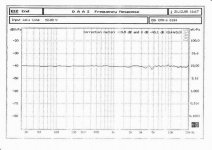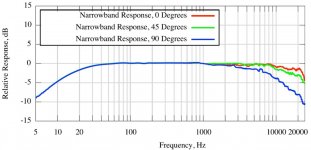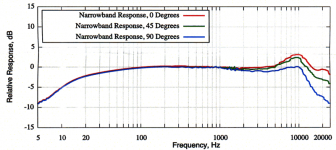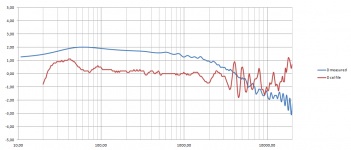The Dayton EMM-6 measurement mic is a great deal at $50 but the calibration files they are supplying are very inaccurate. I had the mic calibration verified by a third party and the Parts Express calibration measurement is way off. Don't use it. The extreme wiggles are measurement artifacts and the flatness of the extension at the frequency extremes is completely incorrect. The first attachment is the PE measurement. The second is the third party calibration.
.
Dayton EMM-6 Electret Measurement Microphone | Parts-Express.com
.
See the thread at PE
.
Dayton mic 3db peak/ dip? - Techtalk at Parts-Express.com
.
.
Dayton EMM-6 Electret Measurement Microphone | Parts-Express.com
.
See the thread at PE
.
Dayton mic 3db peak/ dip? - Techtalk at Parts-Express.com
.
Attachments
Kicking an old thread here, but I've come to the same conclusion. The mics are okay, but only if you use them without the supplied calibration file!
A friend and I both purchased a 'calibrated' Dayton EMM-6 from PE. My friend noticed he was measuring the same narrow-band deviations with different kinds of speakers and suspected it was the calibration file. So we decided to do a comparison measurement with both mics.
FYI, we've plotted the measured difference between both microphones (so no cal used) and the difference between the calibration files. Both plots should be identical, but there's not even a hint of similarity... Measured result is accurate above 200 Hz (gating).
A friend and I both purchased a 'calibrated' Dayton EMM-6 from PE. My friend noticed he was measuring the same narrow-band deviations with different kinds of speakers and suspected it was the calibration file. So we decided to do a comparison measurement with both mics.
FYI, we've plotted the measured difference between both microphones (so no cal used) and the difference between the calibration files. Both plots should be identical, but there's not even a hint of similarity... Measured result is accurate above 200 Hz (gating).
Attachments
Last edited:
I've heard that P.E. has fixed this and the new calibration files are much better. But I don't have confirmation of that.
Looking at Sendler's third party calibration, I'm suspicious. I've never see a mic that flat without EQ. There should be a HF bump on axis related to the size of the capsule. We see it in Dave's plot from the same source, that's what you would expect from a mic of that size and type. Wonder what's up?
Looking at Sendler's third party calibration, I'm suspicious. I've never see a mic that flat without EQ. There should be a HF bump on axis related to the size of the capsule. We see it in Dave's plot from the same source, that's what you would expect from a mic of that size and type. Wonder what's up?
Does anyone know how flat an Audiomatica Clio Mic-01 response is. Is their response chart also wrong ?
What were the serial numbers of the Dayton EMM6's mentioned above.
Mine is 3217 . Any idea if this one comes after the 'correction' by Dayton ?
What were the serial numbers of the Dayton EMM6's mentioned above.
Mine is 3217 . Any idea if this one comes after the 'correction' by Dayton ?
I've heard that P.E. has fixed this and the new calibration files are much better. But I don't have confirmation of that.
We ordered our mics in November of 2010 (serials 888 + 889). Any idea when they supposedly fixed it? 🙂
I suppose we can take a difference signal between a calibrated and uncalibrated mic to determine the performance of the uncalibrated mic. The difference can be nulled ( adjusted for 0 dB ) at 1 Khz. Then the accuracy of the sound source shouldn't matter.
Balanced output ?
Is the output of the EMM6 really a balanced output ? Or is it like the Linkwitz follower with + supply, output and ground ? The EMM6 data sheet says 200 ohms between pin 2 and 3.
Is the output of the EMM6 really a balanced output ? Or is it like the Linkwitz follower with + supply, output and ground ? The EMM6 data sheet says 200 ohms between pin 2 and 3.
The old Behringer had a transformer output, but not now. I have mine apart for repair, I'll look at the preamp for you and try to post a schematic. Tho there may be one floating around the net.
Found a schematic here:
ECM8000 microphone measuring techniques and usage discussion - Page 2 - Home Theater Forum and Systems - HomeTheaterShack.com
Looks balanced. I'll verify if it matches what I have.
ECM8000 microphone measuring techniques and usage discussion - Page 2 - Home Theater Forum and Systems - HomeTheaterShack.com
Looks balanced. I'll verify if it matches what I have.
The ECM8000 and EMM6 both look identical including the carrying case and accessories. However the impedance between pins 2 and 3 is 600 ohms for the ECM 8000 and 200 ohms for the EMM6. Sensitivity for the EMM6 is given as 10mV/Pa ( -40dBV ) . The ECM8000 just says -60dB. WRT to what ?
I did a search and came across the same circuit diagram on that forum. There was another post that actually measured signals on the pins and they used a scope to confirm it. Pin 2 had a signal and pin 3 had no signal ! So maybe what's inside isn't always the same ! 😕
In any case I'm trying out a balanced preamp using a NE5532 with an astable circuit using a 7555 ( cmos timer) running close to 80 Khz with a voltage tripler to get a phantom voltage. It's designed to handle a full 127dB at the mic without clipping . ( 1 V out to the sound card at 127dB or at 80dB spl at the mic). There is a pot to control that.
I did a search and came across the same circuit diagram on that forum. There was another post that actually measured signals on the pins and they used a scope to confirm it. Pin 2 had a signal and pin 3 had no signal ! So maybe what's inside isn't always the same ! 😕
In any case I'm trying out a balanced preamp using a NE5532 with an astable circuit using a 7555 ( cmos timer) running close to 80 Khz with a voltage tripler to get a phantom voltage. It's designed to handle a full 127dB at the mic without clipping . ( 1 V out to the sound card at 127dB or at 80dB spl at the mic). There is a pot to control that.
As mentioned earlier I've been working on a balanced preamp using the NE5532 working off two 9 V batteries. Phantom power derived off the 9 V supply.
Now it occurs to me that possibly it might be interesting to try and make it work off just one 9 V battery.
There will be two 7555 chips . One producing the phantom voltage and the other producing the -ve supply rail. The battery life will go down. Currently I didn't check to see how long it will last.
Is this really a useful idea ?
Now it occurs to me that possibly it might be interesting to try and make it work off just one 9 V battery.
There will be two 7555 chips . One producing the phantom voltage and the other producing the -ve supply rail. The battery life will go down. Currently I didn't check to see how long it will last.
Is this really a useful idea ?
Last edited:
- Status
- Not open for further replies.
- Home
- Design & Build
- Equipment & Tools
- Dayton EMM-6 cal files are wrong



